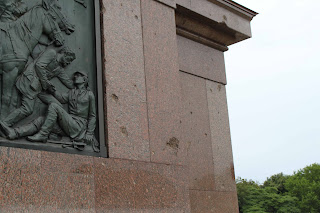 |
| New Reich Chancellery circa 1939 |
When one thinks about old government buildings in the context of Berlin, one almost always thinks about the Reichstag building, beautifully restored and in current use. Similarly, when one is asked to find old Nazi buildings in Berlin, it's a much tougher task. Simply put, the Allies, as well as the Germans, wanted to forget the events of World War II and Nazi rule, so many of the buildings that housed Nazi operations that weren't destroyed in the Battle of Berlin were later demolished. Under this category of demolished buildings includes the headquarters of the SS and Gestapo, now the Topagraphy of Terrors site, and the New Reich Chancellery, where Hitler's top brass had their offices, and was the cornerstone of Hitler's dream empire that was not to be.
In the years prior to the start of World War II, Hitler seemingly had pulled off a miracle: Germany had recovered from the Depression, work was abundant, and the shackles of the Versailles Treaty were finally being thrown down. In 1938, Hitler wanted to begin a new project, making Berlin the capital of a new world empire. This included an almost complete rebuild of most of the city, especially the government quarter. To do this, Hitler appointed his favorite architect Albert Speer, who had previously designed the Nuremburg rally site and the stadium used in the 1936 Berlin Olympics, to design a new Berlin, one that would supposedly 'make Paris look like just another city'.
 |
| Inside of the Chancellery |
While nearly all of the elements of Berlin's rebuild were never completed due to the war, many elements were in fact completed. This culminated in the construction of the New Reich Chancellery. this was built to replace the Old Reich Chancellery, which was built during Bismarck's reign, and deemed by Hitler to be "suitable for a soap company". This new building was meant to be the tip of a new city axis, one that would go east to west, with the Brandenburg Gate in the middle. At the other end of the axis would go the Volkshalle, or People's Hall, where over 180,000 people could sit and hear Hitler speak. If that structure had been completed, it would have been the largest domed structure on the planet.
 |
| Hitler's office |
The New Reich Chancellery housed many of Germany's top officials, and was lavishly furnished. Hitler's office, especially, held many fine examples of art and architecture. If one looks at how big everything is in Hitler's office, the furniture, the paintings, one could say that this was done intentionally to make any visiting diplomat feel small and insignificant compared to Hitler, although this is just a theory.
 |
| Hitler's desk as seen today |
The New Chancellery served throughout the war years, although in the Battle for Berlin it was severely damaged. This was partly due to the fact that the Fuehrerbunker was located in the gardens next to the Chancellory, and also because the Soviets designated targets that would hold significant meaning to the defending Germans in order to effectively destroy them and leave nothing left for the defenders to make a rallied stand around.
After the war, the New Chancellery ended up in East Berlin, and the Soviets did not hesitate to demolish the building. However, pieces of the building were recycled to build their many memorials around Berlin, incorporating the stone into (supposedly) the Soviet War Memorial next to the Brandenburg Gate and into the memorial in Treptower Park. Today, the corner where the Chancellery once stood is occupied by an apartment building and a Chinese restaurant. until next time, take care, and thanks for reading.









